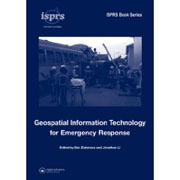
Geospatial information technology for emergency response (ISPRS)
Zlatanova, Sisi
Li, Jonathan
Disaster management is generally understood to consist of four phases: mitigation, preparedness, response and recovery. While these phases are all important and interrelated, response and recovery are often considered to be the most critical in terms of saving lives. Response is the acute phase occurring afterthe event, and includes all arrangements to remove detriments and a long-terminventory of supplies to deal with irreversible damage. The timely provision of geospatial information is crucial in the decision-making process, and can save lives and rescue citizens. The aim of this volume is to share technological advances that allow wider, faster and more effective utilization of geospatial information in emergency response situations. The volume describes current accomplishments and challenges in providing geospatial information with these attributes, and is organized in six parts.
- ISBN: 978-0-415-42247-5
- Editorial: CRC Press
- Encuadernacion: Cartoné
- Páginas: 381
- Fecha Publicación: 21/01/2008
- Nº Volúmenes: 1
- Idioma: Inglés
